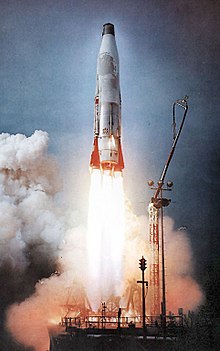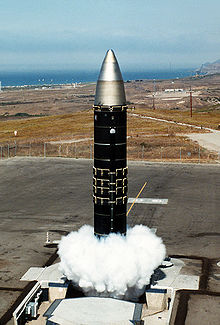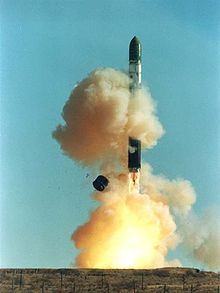Intercontinental ballistic missile
![]()
ICBM is a redirect to this article. For the institute, see Institute of Chemistry and Biology of the Sea.
Intercontinental ballistic missiles (ICBM, Russian Межконтинентальная баллистическая ракета, МБР), or long-range missiles, are long-range ballistic missiles. Their intended use is primarily military as a missile weapon. Intercontinental ballistic missiles are the main means of delivery of nuclear weapons. According to the reading of the SALT II treaties, ICBMs are all ballistic missiles whose range exceeds 5,500 km. The abbreviation ICBM usually refers to land-based systems. Sea-launched intercontinental ballistic missiles are referred to as submarine-launched ballistic missiles (SLBM).
After the rocket-powered launch, the projectile reaches near-Earth space, which is flown through largely without propulsion on a ballistic trajectory (suborbital flight) to the target; the typical range is 5,500 to 15,000 km.
The development of these weapon systems was prompted by the Cold War between the superpowers USA and Soviet Union. In 1957, the first functional intercontinental missile, a Soviet development, was launched, triggering the so-called Sputnik shock and opening a new arms race between the superpowers. In the following period, the so-called balance of terror was established, primarily with intercontinental missiles. For the first time in human history, man can use them to destroy himself. For decades, intercontinental missiles have formed the core of the nuclear forces of the nuclear powers.
In the USA, intercontinental ballistic missiles are also considered space weapons because they travel a large part of their trajectory outside the Earth's atmosphere. As of 1 July 1993, US ICBM forces were incorporated into the Air Force Space Command. Prior to that, control was exercised by Air Combat Command. On October 1, 2002, the United States Strategic Command was merged with the United States Space Command.
In Russia, intercontinental ballistic missiles are under the Strategic Missile Forces.

US Atlas B intercontinental ballistic missile of the first generation (1958)

Minuteman II-ICBM of the second generation

Peacekeeper ICBM third generation

R-36M - Soviet UTTCh (SS-18 mod 4) during take-off
Drive
Whereas first-generation intercontinental ballistic missiles were equipped with rocket engines using partially cryogenic liquid propellants, there has been an increasing shift towards storable liquid propellants and solid propellants. Although rocket engines with solid propellants have a lower efficiency, they are easier to handle and have a shorter reaction time - there is no need to refuel the rocket.
Some modern intercontinental ballistic missiles again have a liquid propellant rocket motor in the final propulsion stage, although this is controllable. These rocket stages are nowadays consistently storable, the propellant is stored for years in the rocket and retains its chemical properties. The controllability allows the missile to be maneuvered until just before impact. On the one hand, this improves accuracy and, on the other, makes defence more difficult, as the trajectory is no longer purely ballistic.
History
The development of intercontinental ballistic missiles began in Germany during World War II with the development of the Aggregat 9 and Aggregat 10. In 1946, the American company Consolidated Vultee Aircraft Corporation presented the MX-774 concept to the US Air Force, which was adopted from Germany after the war. This project, however, had no particular urgency at the time and was poorly funded. However, it was the cornerstone for the SM-65 (Atlas) project, which was given the highest priority by the US Air Force from 1954. The construction of relatively lightweight warheads due to the development and successful testing of hydrogen bombs based on the Teller-Ulam design with solid fuel made intercontinental missiles appear to be a viable option from this point on.
In the Soviet Union, studies for intercontinental ballistic missiles had been carried out since 1950, and development had begun in 1953 with the definition of the criteria for the R-7 missile. Finally, on May 15, 1957, the first unsuccessful test flight of an intercontinental ballistic missile took place at Baikonur. Only the third test flight of the R-7 on August 21, 1957 was successful. Although the re-entry head broke during re-entry, this problem was already known before the flight and was therefore not evaluated negatively.
The flight test program of the Atlas rocket began at Cape Canaveral on 11 June 1957 and, like the first flight of the R-7, was a failure. On 17 December 1957, a flight of an Atlas-A was successful. However, the Atlas-A was only a development model without a central engine and with a greatly reduced range.
On 9 September 1959, the Atlas-D was declared operational by Strategic Air Command and three missiles were placed on alert at Vandenberg AFB. Operational readiness of the Soviet R-7 was declared on 20 January 1960. These first intercontinental ballistic missiles still had many shortcomings in terms of operational readiness and handling. They were powered by liquid oxygen and kerosene. The oxygen could not be stored on board the rocket, which meant that the rocket had to be refueled before a launch. The R-7 was also too large and complex to be stored in a silo for protection. This was possible with the Atlas F, which was deployed from 1962, and the parallel development Titan I, but the constantly evaporating oxygen prevented ignition in the silo, so that the missiles had to be lifted out of the silo on large lifts and only launched on the surface. This increased the cost of the complex system in addition to the response time in the event of an attack. In the Soviet Union only four to eight of the somewhat improved version R-7A were stationed in Baikonur and Plessezk. In the USA 123 Atlas-D, -E and -F and 54 Titan I were stationed. The R-7, Atlas/Titan-1 are called intercontinental missiles of the first generation.
While the first generation of intercontinental ballistic missiles was still being developed, the USA and the Soviet Union began to consider a second generation in the context of the arms race. This was to have storable propellants that could be permanently left in the rocket. Lengthy refuelling before launch, as had previously been the case, was therefore to be dispensed with. These rockets should also be able to be ignited in the silo, which promised a considerable reduction of the reaction time. In the USA one started the development of the Titan II with liquid storable propellant and the solid propellant Minuteman. In the Soviet Union one worked on the R-9 and R-16. The R-9 had like its predecessor oxygen and kerosene as fuel combination, but for it strongly improved characteristics in comparison with the R-7. It was stationed starting from 1965. The R-16 used liquid storable propellants and entered service in late 1963. Titan II and Minuteman entered silos in the USA from 1963.
In 1967, after six years of intensive rearmament, the USA had 1054 Titan II and Minuteman I and II intercontinental ballistic missiles in service. This number remained constant until the end of the Cold War due to the SALT agreement; the Minuteman III (deployed from 1970) and MX Peacekeeper (deployed from the end of 1986) equipped with multiple warheads (MIRV) only replaced the Minuteman I and Titan II. With the retirement of the Titan II in 1987, the U.S. had only solid-fuel and MIRV missiles in its arsenal.
The development of the Soviet arsenal was far more variable than that of the US. After all, there were a large number of different missile types and sub-variants. Unlike the US, the Soviet Union relied heavily on heavy liquid propellant missiles and, in addition to MIRV, retained missiles with single warheads of 20 MT explosive power in its arsenal until the 1990s. It was not until the 1980s that the Soviet Union introduced solid-fuel missiles in large numbers, the Topol and the RT-23. Some of these systems were mobile and stationed on road vehicles and rail cars, making them difficult to locate. The U.S. did not introduce mobile land-based systems, although it was planned several times, such as the Minuteman I, MX Peacekeeper, and most recently the halted Midgetman development.
SALT I of 1972 could not prevent the further expansion of the strategic arsenals; between the early 1970s and 1980 the number of warheads for ICBMs and SLBMs of the two superpowers grew from about 2,000 each - with a slight lead of the USA - to more than 10,000 (USA) and about 9,000 (USSR).
In the 1980s, the increase even continued until it was halted at the end of the decade as a result of global political developments, and since then gradual reductions have been possible.
The only country other than the USA and the USSR/Russia to have put intercontinental ballistic missiles into service is the People's Republic of China. Since the beginning of the 1960s, the country has conducted research in the field of ballistic missiles and was able to put the DF-5 into service in 1981, a missile with storable liquid propellants. Due to its more southerly location compared to the Soviet Union/Russia, Chinese missiles must have a significantly longer range to reach targets in North America. The DF-5 has a range of 13,000 km, while Soviet/Russian missiles are generally designed for ranges of only 8,000 to 11,000 km.
The end of the Cold War brought a drastic disarmament of intercontinental ballistic missiles of the superpowers, nevertheless work on improvements continued. Russia put the Topol-M into service as a modernized version of the Topol. China developed the mobile solid-fueled DF-31 and DF-31A. The U.S. was not developing new intercontinental ballistic missiles, but was conducting a massive modernization program on its Minuteman III arsenal. Other states currently working on land-based intercontinental ballistic missiles include North Korea and India.
.jpg)
Aggregate 9/10 (computer graphics)
Search within the encyclopedia